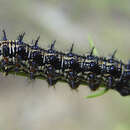pms
nòm ant ël fil


In older texts, buckeyes were known as Precis coenia. However, the binonimal nomenclature has been altered and it is currently referred to as Junonia coenia.
Due to their large abundance, J. coenia is currently not on any endangered species list.
US Federal List: no special status
CITES: no special status
State of Michigan List: no special status
Female buckeyes lay eggs individually on buds and leaves of host plants. The larvae (caterpillars) emerge and feed and grow on the host plant, molting several times. Larvae transform into pupae, and spend the winter in this stage in the northern part of the range. Metamorphosis is completed in the pupal case, and fully developed adult butterflies emerge. They can take flight after their wings dry. In the southern half of the range, this species may develop and reproduce continually with no diapause or winter dormancy.
Development - Life Cycle: metamorphosis ; diapause
Buckeyes, like most butterflies, can be important pollinators.
Ecosystem Impact: pollinates
Adults feed mainly on nectar, and occasionally on mud from the edge of puddles (probably for salts and other minerals).
Caterpillars feed on a wide variety of host plants, nearly all herbaceous (see partial list below). Females may be stimulated to oviposit by the presence of iridoid glycosides (Kluts, 1951, Scott, 1986).
Foods eaten: plantains (Plantago), gerardia, toadflax (Linaria), wild snapdragons (Antirrhinum), false loosestrife (Ludvigia), stonecrop (Sedum).
Plant Foods: leaves; nectar
Primary Diet: herbivore (Folivore , Nectarivore )
This species occurs in southern Canada east of Saskatchawan, and throughout the United States except for Montana, Idaho, Washington, and western Wyoming. From there it ranges south and east to Bermuda, the Bahamas, Cuba, nearly all of Mexico except southern Baja California.
Biogeographic Regions: nearctic (Native )
Other Geographic Terms: island endemic
Junonia coenia tends to like more open areas such as fields, parks, pastures, meadows, and coastal dunes. You can also find them along roadsides and in other disturbed, weedy places. They are often near their food plants, and may also feed or drink around mud puddles.
Habitat Regions: temperate ; tropical ; terrestrial
Terrestrial Biomes: desert or dune ; chaparral ; scrub forest
Other Habitat Features: urban ; suburban ; agricultural
Junonia coenia does not live a long time. Adults live about ten days in nature, and about a month in a lab. Larvae and adults may overwinter in warm climates (California lowlands, and regions with similar climate).
The eggs of Junonia coenia are a dark green.
The larva that hatch from the eggs are nearly black and have two rows of orange-cream spots along the middorsal. There are two lateral rows of cream spots and the larva has many bluish-black spines. The prolegs are orange. The head is black with an orange spot toward the anterior and two short black spines on top, and orange on the top and sides.
Pupa color varies from light color with brownish-orange blotches, to entirely brownish-orange, to nearly black.
The adult stage of the butterfly has brown wings with three eyespots per wing, one on the upper and two on the hindwing. There are characteristic orange bands on the forewing. They have a particularly large eyespot on the hindwing that is reddish to purple. Adult coloration varies, with a form called "rosa," (with red under-hindwings) that appears late in the fall in eastern U.S., and may be a result of short daylength or lower temperatures.
Range wingspan: 4 to 6 cm.
Other Physical Features: ectothermic ; heterothermic ; bilateral symmetry ; polymorphic
Males perch on the ground or low plants and watch for passing females. They pursue any likely object. Females inclined to mate will land, and the male will follow. Courtship behavior is variable. Sometimes they land, fold their wings, and mate. On other occasions females have been observed fluttering their wings after landing. The male responds by hovering over her and fluttering his wings as he lands behind her. The male will then pursue her by nudging her from behind. They will then mate, or if she chooses not to mate, she will flap her wings with a high intensity, spread her wings and lift her abdomen to deny him access, or just fly away.
Mating System: polygynous
After mating, female buckeyes lay their eggs on the leaves of host plants that their larvae will eat. In the northern part of the range there may only be one or two generations a year, and it's unlikely that adults can survive the winter. Further south (Florida, Texas, California and beyond), there are adults flying nearly all year.
Breeding season: Year-round in southern range, narrowing to summer in the north.
Key Reproductive Features: semelparous ; seasonal breeding ; year-round breeding ; gonochoric/gonochoristic/dioecious (sexes separate); sexual ; fertilization (Internal ); oviparous
There is no parental care in this species.
Parental Investment: no parental involvement